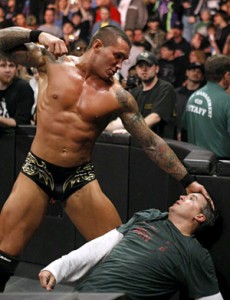“..Contemporary sports entertainment which treats ‘professional wrestling’ as an action/adventure soap opera. With the sexuality of ‘90210,’ the subject matter of ‘NYPD Blue,’ the athleticism of the Olympics, combined with reality-based story lines, the WWF presents a hybrid of almost all forms of entertainment and sports combined in one show.” -Vince McMahon, head of the WWE
 However, one form of entertainment stands out to me above the rest. It is one that doesn’t just condone violence, but supports it, even thrives on it. It needs violence in order increase its ratings, and thus its profits. What am I talking about exactly? Professional wrestling, specifically the World Wrestling Entertainment (WWE). The WWE has long thrived on making violence the norm, celebrating both violence and bullying as trademarks of masculinity. What else is the WWE teaching us as a society, about ourselves and the dominant narratives in our culture? Let me explain.
However, one form of entertainment stands out to me above the rest. It is one that doesn’t just condone violence, but supports it, even thrives on it. It needs violence in order increase its ratings, and thus its profits. What am I talking about exactly? Professional wrestling, specifically the World Wrestling Entertainment (WWE). The WWE has long thrived on making violence the norm, celebrating both violence and bullying as trademarks of masculinity. What else is the WWE teaching us as a society, about ourselves and the dominant narratives in our culture? Let me explain.
- Masculinity: First and foremost, the WWE is about masculinity. A masculinity that can be defined simply through physical strength and dominance. Brute force is a measure of success. Violence is used as a means of leveraging one’s strength, power, and control. The wrestlers never back away from a confrontation, instead racing towards it as a way to prove their worth. Violence is used to settle scores, win conquests, and ultimately defend one’s honor.
- Violence: In what some would refer to as “happy violence”, the wrestlers of the WWE are subjected to gruesome punches, kicks, and throws, however never end up with even a scratch. In the WWE, no one ever gets hurt. Not really. The spontaneous recovery of many of the wrestlers can be attributed to the fact that almost all the moves in the WWE are choreographed, allowing the wrestlers to “act out” a sequence for the audience rather than engaging in a real fight. The problem is – this doesn’t happen in real life. In reality, there is no script, no choreographer, no producer behind the scenes. In reality, there are real consequences to violence.
- Bullying: What’s the WWE without a little bullying? Not much, if we’re looking strictly at the time schedule. In professional wrestling, very little time is actually dedicated to the fight itself. The majority of the broadcast is spent setting up the narrative, as wrestlers verbally taunt and threaten their opponents in order to belittle them, calling both their courage and manhood into question.
- Femininity: Which brings me to my last point – femininity. In most cases, women are placed in a supporting role, used only as “tokens” for the men to win as a reward for their physical accomplishments. The few women who go on to become professional wrestlers in their own right are painted as highly sexualized female aggressors, used simply for the pleasure of the male viewers at home.
Many people laugh at the notion that we should take the WWE seriously, stating that everyone should relax because it’s just entertainment. Isn’t that part of the problem? Entertainment is one of the most powerful influences in our society. It transmits values, fosters ideas of normalcy, and is a main tool in socialization for our youth. You might know that the WWE is one of the highest rated cable programs on television. However, did you know that the primary audience of the WWE is young men? The target market for the WWE is both children, and men ages 18-34, as both demographics are ultimately its biggest money makers.
What is the WWE really teaching us? It’s teaching us a storyline of masculine domination. Feminine inferiority. And violence as a cultural norm. Yet, the WWE television shows all continue to hold a simple TV-PG rating. Parental guidance simply suggested. Seems awfully soft for a show based around the themes of violence, sexuality, and intimidation. Isn’t it time we switch it back to a TV-14 (parents strongly cautioned) or TV-MA (mature audience only) like it belongs? As a show that should be left for adults, who (hopefully) can realize the theatrical nature of the show, and filter its harmful content. What is your opinion on the WWE’s current television rating? Do you think it should be changed?


